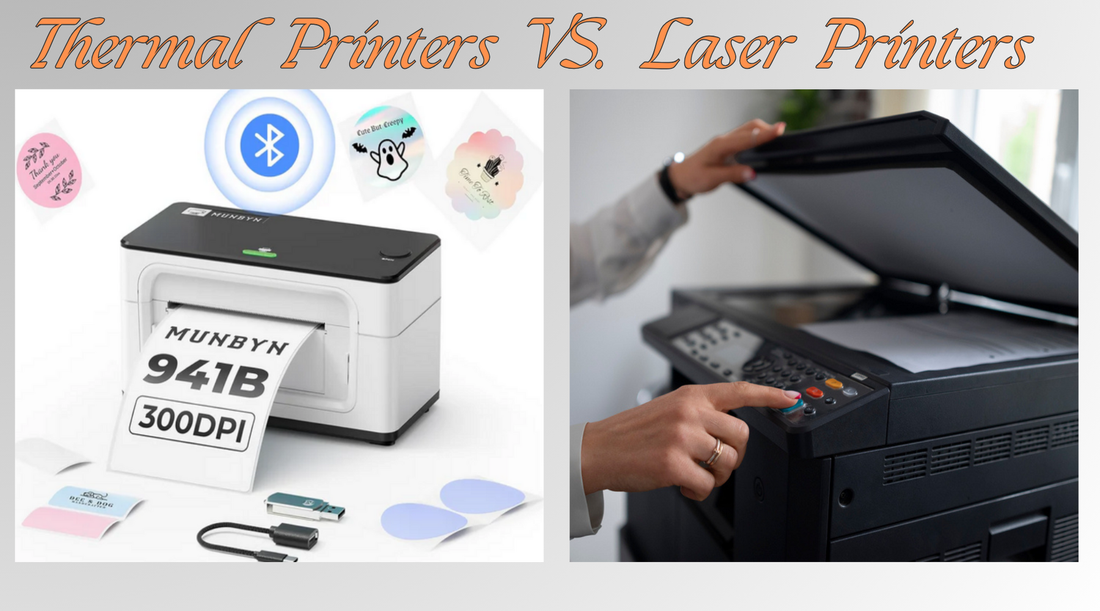Thermal VS. Laser Printer: Key Differences You Should Know

In the ever-evolving world of printing technology, choosing the right printer can feel overwhelming. With so many options available, it's easy to get lost. But don't worry, we're here to help you make an informed decision. Whether you're printing shipping labels for your small business or crafting art projects at home, understanding the differences between thermal and laser printers is key to making the best choice.
What is a thermal printer?
A thermal printer uses heat to produce images on paper. Unlike traditional printers that use ink or toner, a thermal printer has a special paper coated with heat-sensitive chemicals. When the printhead applies heat to this paper, it changes color to create text or images.
One of the biggest advantages of thermal printers is their simplicity. Because they don't have as many moving parts, they're generally more reliable and require less maintenance. This makes them a great choice for environments where uptime is critical, such as retail stores or warehouses.
Thermal printers are also known for their speed. They can print barcodes, receipts, and labels quickly, which is why you'll often see them in supermarkets and other fast-paced settings. They're designed to handle large volumes of printing without overheating or breaking down.
Another feature worth noting is their compact size. Thermal printers are often smaller and lighter than their laser counterparts, making them easy to move around and store. This portability is especially useful if you're setting up a mobile point-of-sale system or need a printer for on-the-go tasks.
In terms of applications, thermal printers are incredibly versatile. They can be used for everything from printing shipping labels and brand logos to creating creative stickers and DIY crafts. Their ability to produce clear, durable prints makes them ideal for both business and personal use.
What is a laser printer?
A laser printer works by using a laser beam to transfer toner (a powdered form of ink) onto paper. The laser creates an electrostatic image on a drum, which then attracts the toner. The toner is then fused to the paper using heat, resulting in a high-quality print.
One of the standout advantages of laser printers is their print quality. They offer high resolutions, typically ranging from 600 to 1200 DPI, making them ideal for professional documents and detailed images. If you need to print in color, a laser printer has you covered.

Laser printers are also known for their efficiency. They can handle larger print jobs more quickly than most other types of printers. This makes them a popular choice for offices and businesses that require high-volume printing.
When it comes to features, laser printers often include advanced functions like duplex printing (printing on both sides of a sheet), network connectivity, and even built-in security features. These extras can be particularly beneficial in a busy office environment.
In terms of applications, laser printers are versatile but tend to be more focused on professional use. They're perfect for printing high-quality business documents, reports, and marketing materials. Their ability to produce sharp, crisp text and detailed images makes them a favorite in corporate settings.
The major difference between thermal & laser printers
|
Feature |
Thermal Printer |
Laser Printer |
|
Printing Technology |
Heat-based |
Laser or toner |
|
Print Quality |
Good for simple images and text |
Good for high-resolution images |
|
Cost |
Lower cost in the long term |
Higher initial & maintenance cost |
|
Maintenance |
Not so frequent |
Need regular maintenance |
|
Speed |
Relatively fast for labels, stickers & receipts |
Fast for large document batches |
|
Versatility |
Limited to black & white, small format |
Able to print in color, suitable for a variety of formats |
1. Printing Technology
Thermal printers use heat to activate dyes on specially coated paper, while laser printers use lasers to transfer toner onto paper. This fundamental difference affects everything from print quality to speed and maintenance needs.
2. Print Quality
Laser printers excel in producing high-resolution images and detailed text, making them ideal for professional settings. On the other hand, thermal printers are better suited for printing simple graphics and text, like barcodes and receipts.
3. Cost
Thermal printers usually have a lower initial cost compared to laser printers. They don't require ink or toner, which means you save money on these supplies in the long run. While you do need specialized paper for thermal printers, the overall expense tends to balance out, making them more cost-effective over a longer term.
On the other hand, laser printers come with a higher upfront cost and require regular purchases of toner cartridges. Although the per-page cost of toner might be lower, the ongoing costs can accumulate, making laser printers more expensive to maintain over time.
4. Maintenance
Thermal printers are generally low-maintenance because they have fewer moving parts. Laser printers, however, require regular upkeep, including replacing toner cartridges and sometimes cleaning the machine to ensure optimal performance.
5. Speed
Both types of printers are fast, but they excel in different areas. Thermal printers are particularly quick when it comes to printing label stickers and receipts. Laser printers are faster for bulk document printing, making them suitable for office environments.
6. Versatility
Laser printers are more versatile, offering color printing and handling various paper sizes and types. Thermal printers are typically limited to black-and-white output and smaller formats, making them less flexible but highly efficient for specific tasks like label printing.
You may also want to know: AirPrint VS. Bluetooth Printers: Which Suits You Best?
Which one should you choose?
When deciding between a thermal printer and a laser printer, there are several factors to consider. Your decision will ultimately depend on how frequently you plan to use the printer and what you primarily intend to print.
Choose thermal printers
If you're a small business owner, DIY enthusiast, or someone who needs a printer for home use, a thermal printer might be the best option for you. These printers are excellent for making creative stickers, labels, and other decorative items that can add a unique touch to your daily life. They are also perfect for printing shipping labels, brand logos, and other business-related materials.
Thermal printers are known for their fast printing speeds and low power consumption. Because they don't require ink or toner, your ongoing costs will be relatively low. They're also portable and easy to use, making them a great tool for both business and personal applications. However, keep in mind that thermal printers generally only print in black and white, and their resolution (usually 203 or 300 DPI) can't compete with that of laser printers.
Here’s the best part: Use the limited-time code MY06 when you purchase MUNBYN products now and get an extra 6% off your order!
Choose laser printers
On the other hand, if you need high-quality, professional prints, a laser printer is likely the better choice. These printers offer superior image resolutions and can print in a variety of colors. They are well-suited for a wide range of applications, from producing marketing materials and business reports to printing photos and other detailed images.
Laser printers do come with a higher purchase cost and require regular maintenance. You'll need to replace the toner cartridges periodically, which can add to the overall cost of ownership. Additionally, they consume more power than thermal printers, so your electricity bill may reflect that. However, their versatility and ability to produce high-resolution prints make them a worthwhile investment for many users.
So, which one is better? It all comes down to your specific needs. If you need a printer for high-volume, professional-quality printing, go with a laser printer. If you want something that's fast, portable, and affordable for everyday use, a thermal printer is the way to go.
The bottom line
Choosing between a thermal printer and a laser printer depends on your specific needs and priorities. Thermal printers are great for quick, cost-effective printing of labels, receipts, and simple designs. They’re perfect for small businesses and DIY enthusiasts. Laser printers, with their high-quality output and versatility, are better suited for professional environments where print quality is paramount.
Remember, the best printer for you is one that meets your individual needs and fits within your budget. Consider what you’ll be using it for most often, and let that guide your decision.



